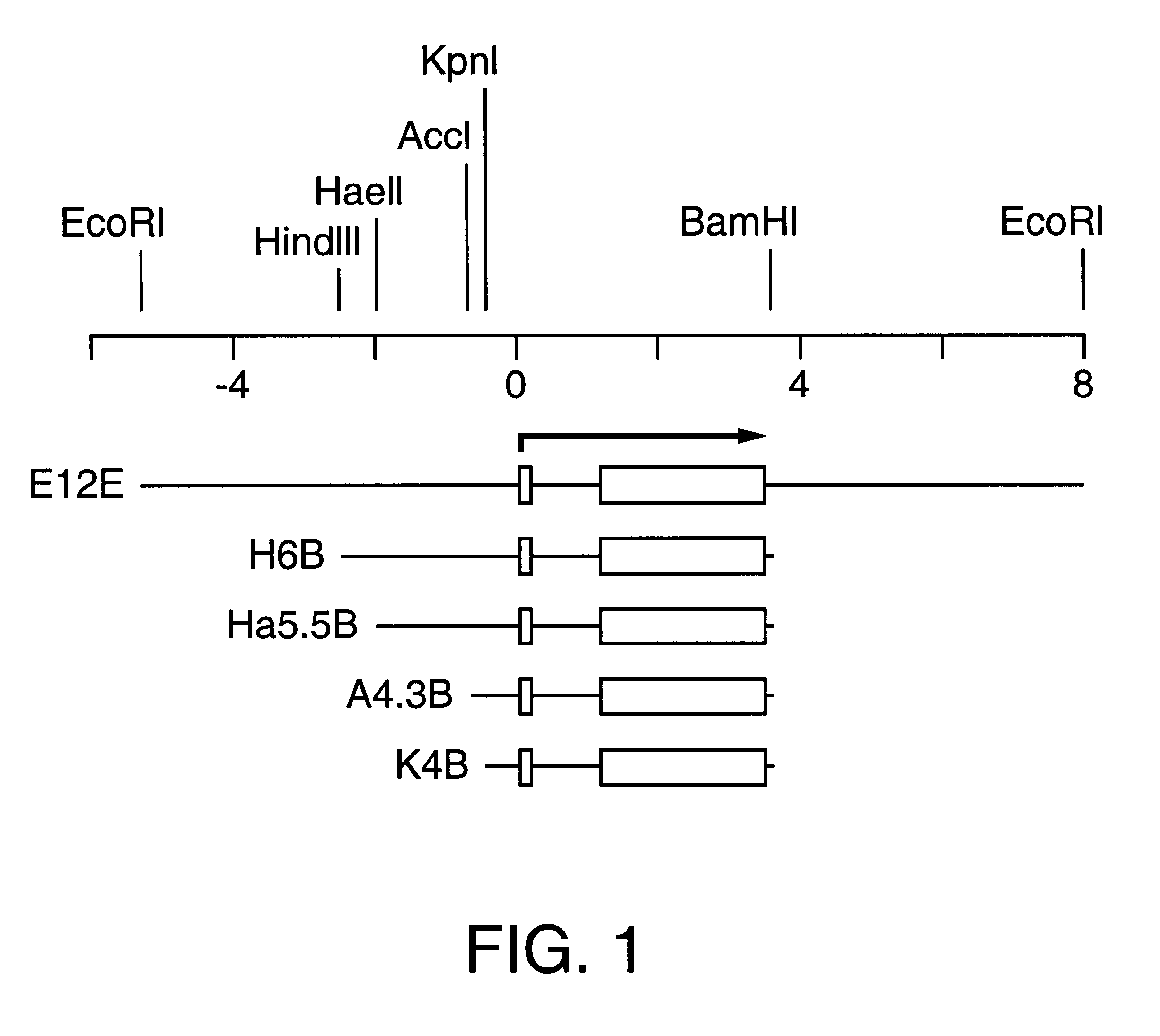Tissue specific promoters and transgenic mouse for the screening of pharmaceuticals
a tissue specific promoter and mouse technology, applied in the field of tissue specific promoters and transgenic mice, can solve the problems of difficult determination, high risk of repeated damage, and animals treated with chemicals that exhibit a multitude of genetic and metabolic alterations, and achieve the effect of restoring the activity of hinv promoters
- Summary
- Abstract
- Description
- Claims
- Application Information
AI Technical Summary
Benefits of technology
Problems solved by technology
Method used
Image
Examples
example 1
Generation of Transgenic Mice
A. Construction of hINV transgenes.
E13E was constructed by EcoR1 digestion of .lambda. phage, Charon 4A .lambda.I-3 (Eckert and Green "Structure and evolution of the human involucrin gene" Cell 46:583-589, 1986). A 13-kb EcoR1 fragment was then subcloned into pBKS (+) to yield pBKS-E13E. The EcoR1 insert from this plasmid is shown in FIG. 3. The H6B transgene is a 6-kb HindIII / BamHI fragment that was derived by restricting Charon 4A .lambda.I-3 with HindIII / BamHI and subcloning the resulting 6-kb fragment into HindIII / BamHI-restricted pSP64 to yield pS64.lambda.I-3 H6B (Eckert and Green "Structure and evolution of the human involucrin gene" Cell 46:583-589, 1986). Promoter deleted transgenes were constructed by taking advantage of unique restriction sites located upstream of the transcription start site. Consequently, the Ha5.5B transgene was generated by digesting pSP64.lambda.I-3 H6B with HaeII / BamHI and isolating the HaeIIBamHI. Likewise, the A4.3B an...
example 2
A 520-bp Segment of the hINV Upstream Regulatory Region is Required for hINV Expression in Epidermis.
A. Detection of hINV protein expression.
To detect expression of the hINV protein in mice, expression of the hINV protein by immunoblot of whole cell extracts was assayed in epidermis and kidney as described proviously (Crish, et al., "Tissue-specific and differentiation-appropriate expression of the human involucrin gene in transgenic mice: an abnormal epidermal phenotype" Differentiation 53:191-200, 1993). Briefly, to detect hINV expression in mouse tissues, total protein extracts were prepared from tissue samples in Laemmli sample buffer, electrophoresed on acrylamide gels, and transferred to nitrocellulose for immunoblot. The blot was incubated with a primary antibody prepared against human involucrin, diluted 1:8000 as described previously (Crish, et al., "Tissue-specific and differentiation-appropriate expression of the human involucrin gene in transgenic mice: an abnormal epide...
example 3
Differentiation Appropriate Expression of the hINV Transgene
We used immunological techniques to evaluate the differentiation-dependence of expression (FIG. 4). hINV was detected in the upper spinous and granular layers in footpad epidermis (EP1, left hand column) in E13E and H6B mice but no expression was detected in the basal layer (arrowheads). Suprabasal expression was also observed in the ectocervical epithelium (EC, right hand column) in these mice. In contrast, no expression was observed in epithelium or epidermis of transgenic strains Ha5.5B or K4B (FIG. 4), and no expression was observed in nontransgenic mice (not shown). FIG. 5 shows transgenic expression in the kidney of K4B mice. In this, and all other lines, expression in kidney was confined to the epithelia lining the distal convoluted tubule in transgenic lines.
The results discussed in Examples 3 and 4 suggest the regulatory elements are localized within the -2473 / -1953 segment. To identify the sequence of these regula...
PUM
| Property | Measurement | Unit |
|---|---|---|
| Volume | aaaaa | aaaaa |
| Nucleic acid sequence | aaaaa | aaaaa |
Abstract
Description
Claims
Application Information
 Login to View More
Login to View More - R&D
- Intellectual Property
- Life Sciences
- Materials
- Tech Scout
- Unparalleled Data Quality
- Higher Quality Content
- 60% Fewer Hallucinations
Browse by: Latest US Patents, China's latest patents, Technical Efficacy Thesaurus, Application Domain, Technology Topic, Popular Technical Reports.
© 2025 PatSnap. All rights reserved.Legal|Privacy policy|Modern Slavery Act Transparency Statement|Sitemap|About US| Contact US: help@patsnap.com

